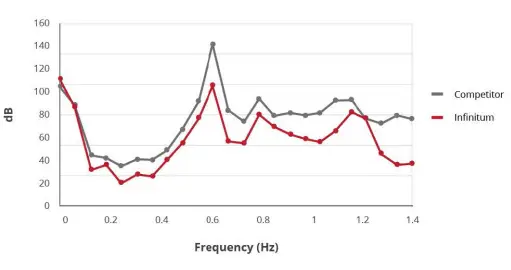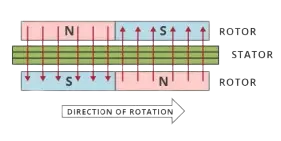WHITEPAPER
Low Acoustic Noise and Low
Some of the benefits of Infinitum’s innovative PCB stator design are the low acoustic noise due to the absence of normal magnetic forces1 acting between the rotor and the stator and negligible torque ripple due to the absence of reluctance torque.
In a typical electric machine, both the stator and rotor are built out of ferromagnetic materials. Once electric currents are applied to the winding of the machine, rotating magnetic fields are established. These magnetic fields produce two forces: one that produces useful torque and causes the rotor to rotate and one that pulls the rotor radially towards the stator, similarly to the force that pulls two magnets together. The latter not only does not produce useful torque, but because of its pulsating nature due to presence of slots in the stator, it also contributes to noise and vibration. The Infinitum motor does not use any iron in its stator, therefore, there are no slots in the stator or forces pulling the rotor towards the stator.

Other sources of noise in electric machines are the blowers (internal and external) needed to cool the machine. The Infinitum motor does not produce core losses, and similarly to most permanent magnet machines, has negligible rotor losses. The only significant losses are I2R losses and eddy current losses in the copper, eliminating, or substantially reducing, the need for internal blowers, which allows for quieter machines.
The chart below shows the result of noise measurements conducted by an independent third party, comparing an Infinitum Electric motor to a competitor’s motor with same rating. Both machines do not have blowers, and the competitor’s motor has an iron core stator. The Infinitum Electric motor produces an average of 3 dB lower sound power noise across the entire frequency range.
The chart below shows the result of noise measurements conducted by an independent third party, comparing an Infinitum Electric motor to a competitor’s motor with same rating. Both machines do not have blowers, and the competitor’s motor has an iron core stator. The Infinitum Electric motor produces an average of 3 dB lower sound power noise across the entire frequency range.


Figure 1: Magnetic forces acting on the rotor in an iron core electric machine.
Iron core electric machines typically have some torque pulsations due to the variations in the reluctance as the rotating magnetic field travels around the motor. Figure 1 below shows a section of the airgap in an iron core machine, where the position of the rotor relative to stator is such that the magnetic flux produces a magnetic force in the same direction of rotation of the machine. The magnetic force acts in such a way as to reduce the reluctance of the magnetic path. As the rotor moves in the direction of rotation, the alignment of the rotor poles changes relative to the stator to a point where the magnetic flux produces a force in the opposite direction of rotation. This force alternating magnetic force will produce a torque ripple.

Figure 2: Magnetic flux line across the airgaps and stator in an air core electric machine.
The Infinitum motor does not have an iron core or slots, so the distribution of the magnetic flux across the airgaps and stator remains constant and the machine rotates as shown in Figure 2. Therefore, there is no pulsating magnetic force acting on the rotor.